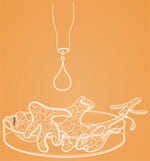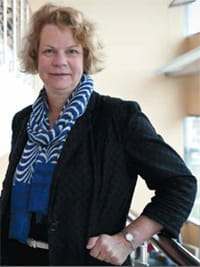Small but Mighty

A small group of scientists aims to solve the mysteries of infections that have baffled us for decades. Their work has earned the Division of Infectious Diseases its place as our top-funded research group
In the weakened body of a hospitalized child, the common yeast Candida can quickly transform from a passive presence on the skin and in the GI tract to an invasive, destructive fungus. Gaining entrance often through a central venous line, the fungus travels through the bloodstream into the most remote recesses of the body, eating away at tissue and allowing toxins and bacteria to enter the system at an alarming rate.
 |
|
Dr. Peggy Hostetter and her team are unlocking the mysteries of infections that have puzzled science for years. |
So it was with a young patient Peggy Hostetter, MD, recalls from some 25 years ago — a little boy undergoing chemotherapy for leukemia who developed a Candida infection from his central line.
“I was a young attending in infectious disease at the University of Minnesota,” Hostetter recalls. “I’d seen lots of kids with Candida infections. I knew we could treat it and cure him with amphotericin, the only drug we had for the infection back then.”
Hostetter explained this to the boy’s parents. The child died within 48 hours.
Shocked by this turn of events, she searched the literature to see what was known about Candida.
“There was nothing there,” she says. “So I decided, ‘I’ve got to study this.’”
Study it she did. And now Hostetter, who is Director of the Division of Infectious Diseases at Cincinnati Children’s, has made a potentially game-changing finding that she believes could prevent infections like that young boy’s.
Hostetter’s research revealed that the heparin fed through central lines to prevent clotting binds with the Candida yeast that lives on and in all of us. Candida uses this binding to elude the body’s defenses and to form biofilms within catheters. Biofilms are the first step in bloodstream infections with the yeast.
The agent that Hostetter and her team developed prevents this binding; the discovery has been patented and the medical center is seeking licensing for human trials.
TOP-FUNDED RESEARCH DIVISION
Such breakthrough research and discovery is the daily work of Hostetter’s division, and the reason the group of only eight extramurally funded research faculty is the highest-funded research group at Cincinnati Children’s at $10.5 million.
The division has a history of discoveries, from the oral polio vaccine developed by Albert Sabin, MD, to the Rotarix rotavirus vaccine developed here by David Bernstein, MD, and Richard Ward, PhD, in 2004.
Hostetter was aware of the legacy she inherited when she took her post in 2010. She was confident she could continue the tradition, even as she set a new course.
“I’m not going to be the inventor of a tremendous life-saving vaccine,” she says, “but there were other ways I could contribute.”
TRIAL BY FIRE
She had the opportunity to demonstrate those contributions early on. Just 18 months after she arrived, Hostetter’s division would undergo Scientific Advisory Committee (SAC) review. The review is an intensive look by outside experts and medical center leaders at how the division is doing, and how it measures up to other such divisions nationally.
During her recruitment to Cincinnati Children’s, Hostetter had prepared a business plan – a strategic vision for staff she wanted to recruit, space she would need, and budget. She had received everything she asked for.
“I knew the SAC reviewers would say, ‘You have the vision and you got the resources. Now, can you execute?’”
And after just 18 months, Hostetter was able to point to some significant achievements: steadily increasing external research funding and clinical activity.
Her business plan had called for hiring six new investigators and starting two new clinical programs, one in transplant infectious disease and one in antimicrobial stewardship. As of SAC review time, she had signed commitments with three new faculty – Sing Sing Way, PhD, who studies the immunology of pregnancy, Joe Qualls, PhD, who works on the macrophage, and Lara Danziger-Isakov, MD, MPH, an expert in transplant infectious disease.
 |
|
The Division of Infectious Diseases has more than tripled clinical revenues since 2010. |
CLINICAL INVOLVEMENT IS KEY
The plan also called for increasing the division’s clinical activity; in just 18 months, their clinical consults increased to the point where clinical revenues doubled, topping $700,000 in billings. The division opened a general infectious diseases clinic at the hospital’s sub- urban Liberty campus and a travel medicine clinic at its main Burnet Avenue location. Clinical revenues at the close of FY13 topped $1.4 million - yet another doubling.
“Our research is important, but as a clinical division within a major children’s hospital, we also have an important clinical mission,” Hostetter says.
She believes this clinical involvement informs their research and expands the legacy of physician-scientists like Sabin and Bernstein.
“The division’s previous research covered the map on norovirus, rotavirus, herpes, cytomegalovirus,” she notes. “It was vitally important work, and we have built on that legacy to cover areas beyond virology.”
AN HONEST LOOK
Hostetter was grateful to have SAC reviewers who were national leaders in Infectious Disease confirm that the division is on the right track – and corroborate what needs improvement. The reviewers agreed that the division’s fellows needed more protected research time, and that finding more research space and continuing to recruit should be priorities.
Now, little more than one year after the review, growth continues. The division’s clinical volume has now tripled. Hostetter and Beverly Connelly, MD, fellowship director, have restructured clinical time for infectious disease fellows to give them protected time for research. And Hostetter recently hired David Halsam, MD, to develop an antimicrobial stewardship program.
Hostetter credits much of the growth to unwavering support from medical center leadership, including members of the Board of Trustees who attended her SAC review and have shown keen interest in helping her build a successful research and clinical enterprise.
But the single greatest factor in her division’s success, Hostetter believes, is its people.
“Every one of us who contributes to the clinical and research missions can think of that one child who made us say, ‘I’ve got to figure this out.’”
LEADING RESEARCH PROJECTS IN INFECTIOUS DISEASES
 Rhonda Cardin, PhD, studies viral/host interactions in cytomegalovirus and is currently working on the connection between cytomegalovirus and congenital deafness.
Rhonda Cardin, PhD, studies viral/host interactions in cytomegalovirus and is currently working on the connection between cytomegalovirus and congenital deafness.
Peggy Hostetter, MD, explores Candida and central line infection, which has led to the discovery of an antibody that interrupts the binding of Candida to heparin. It has been patented; next steps are licensing and the move to human trials.
Funding by the Gates Foundation has led to research finding that asymptomatic vaginal infection with Candida in pregnant women may be linked to preterm birth. Hostetter’s team has developed an inexpensive, easy-to-deliver agent that stops this process. It is now ready for testing in an animal model.
Nancy Sawtell, PhD, studies reactivation of herpes simplex virus in rodent models.
Xi Jason Jiang, PhD , and Ming Tan, PhD, study enteric viruses and have produced a recently licensed vaccine against the human norovirus.
David Bernstein, MD, is currently collaborating on a vaccine that shows promise for reducing the number of relapses in people suffering from herpes simplex genital infections.
Joseph Qualls, PhD, examines the molecular aspects of macrophage biology during disease, specifically, how macrophages use amino acids and the effect on infection and inflammatory disease.
Sing Sing Way, MD, PhD, studies pregnancy from an immunologic standpoint.



